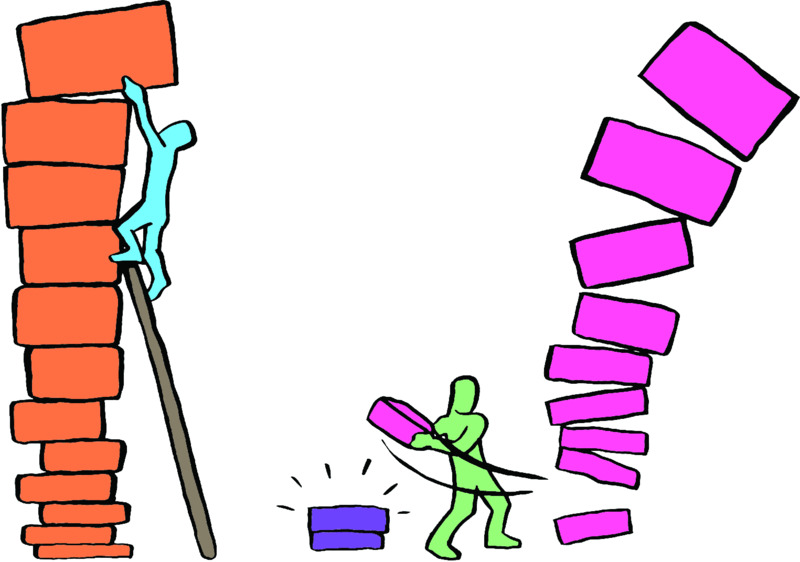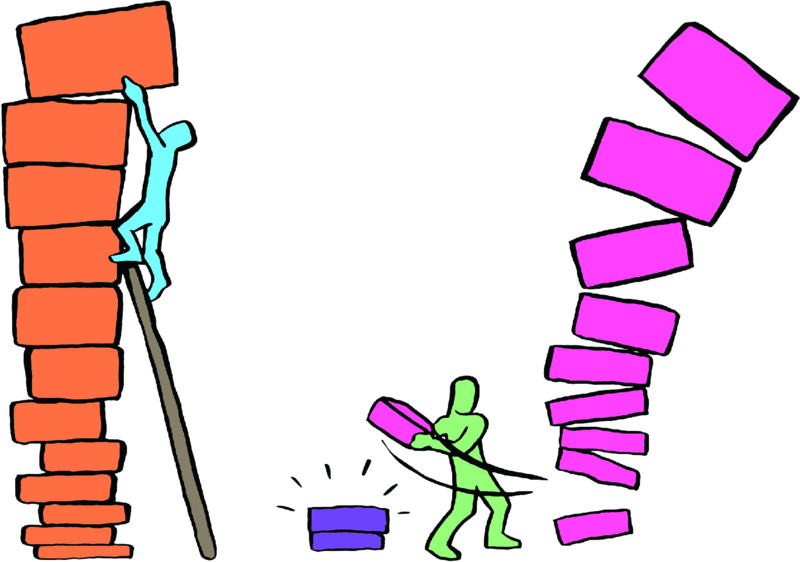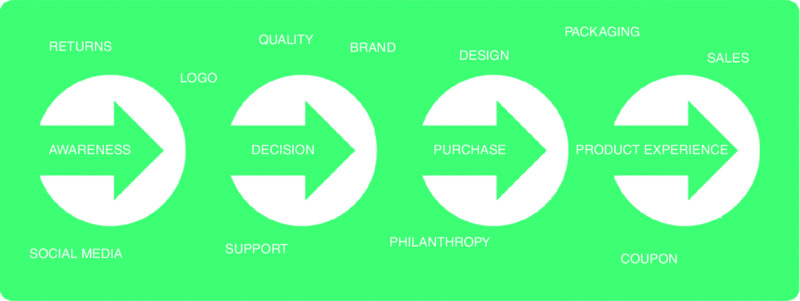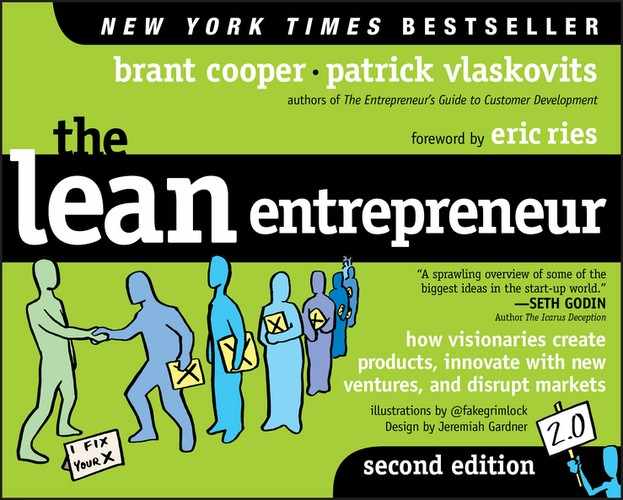1
STARTUP REVOLUTION

Welcome to the Age of Value Creation. If your organization is not creating value for customers, you are done. If you are focused on wealth creation, if your objective is to profit off fomenting fear or instilling insecurities, or if your business model depends on spoon-feeding solutions, you are done.
In the value creation economy, the customer has the power. The technological transformation we are witnessing provides both consumers and business buyers with vast amounts of knowledge about markets, products, features, capabilities, and reputation; myriad products and companies to choose from; and the power to more easily switch from one company to another. Knowledge at our fingertips comes from the Internet and computers in our pockets; it is easier than ever for customers to curate, analyze, and share opinions and information. Product and company choice comes from globalization, the rise of entrepreneurs and freelancers, and market-expanding enterprises.
All this change has created new rules in the economy: The customer has the power, so you must be focused on creating value for and maximizing the experience of the customer.
Further, we are arguably at the beginning of these trends. The breakthrough technologies of artificial intelligence, robotics, digital fabrication, and open-source hardware will continue to push power to the customer. Customers will increasingly be able to design custom-fit solutions for their individual pains and passions.
These changes don’t come without costs. These changes disrupt the existing economy, collapsing relatively young enterprises like Blockbuster and Borders, decades-old household names like Kodak, and even century-old stalwarts like Nokia, putting tens of thousands of people out of work.
Disruption hurts.
Even in the best of times it’s the worst of times: The very structure of the global economy is changing, forever. Millions are unemployed and suffering worldwide. Manufacturing is not merely being sent offshore; it’s being permanently displaced, even in China. Service jobs are the capitalists’ new “unit of labor.” White-collar jobs are being sent offshore. Online marketplaces are turning college-education skills into commodities. At the online workplace Upwork, customers can get competing bids from onshore and offshore contract freelancers or businesses: engineering, accounting, marketing, sales, website development, design, customer service, technical support, administrative assistance, writing, editing, translating, human resources (HR), legal, recruiting, statistical analysis, and information technology (IT).
One of Henry Ford’s great insights was that if he could produce a car at a price his workers could afford, he’d have a huge market.
As entrepreneur and author Seth Godin writes, “The factory—that system where organized labor meets patient capital, productivity-improving devices, and leverage—has fallen apart. Ohio and Michigan have lost their ‘real’ factories, just as the factories of the service industries have crumbled as well. Worse still, the types of low-risk, high-stability jobs that three-quarters of us crave have turned into dead-end traps of dissatisfaction and unfair risk.”1
What will people do for a living?
What’s going on? It’s pretty hard to wrap your head around. Economic growth indicators that describe the past to help us plan for the future will be revised backward soon. (Don’t worry; experts will be on hand to explain.)
It’s not just the economy, either; it’s how we talk about it. Political institutions have never seemed so clueless, having the same arguments they had in the 1950s. The media is equally flummoxed, having given up trying to separate political fact from fiction, science from opinion. Pundits are proven wrong on a daily basis, only to be trotted out before the masses for their opinions again. Economists run models based on assumptions that have no real-world bearing.
There’s a lot of doom-and-gloom prophecy reminiscent of the eighteenth-century cleric Thomas Malthus, who wrote that “the power of population is so superior to the power in the earth to produce subsistence for man, that premature death must in some shape or other visit the human race.”2
Yet, tech hubs of entrepreneurial activity are thriving not only in Silicon Valley, Manhattan, Santa Monica, and Boston, but in Boulder, Grand Rapids, and San Diego.
We find ourselves amid a tremendous storm of economic, technological, and cultural transformation. We are experiencing massive waves of change, high tides of anxiety, and a tumultuous backwash of resistance. This disruption has created an odd mixture of extraordinary market efficiency and entrepreneurial innovation, coupled with volatility and uncertainty at unprecedented levels.
How do you face uncertainty?
To survive and indeed to prosper through these changes, whether as an individual, a startup, or a large enterprise, you must be fast, efficient, and value-creating. You must be close to your customer, be optimized for learning, and use data to help inform decisions. You have to be lean.
BYTES EATING THE WORLD
In 2011, famed Internet-entrepreneur-turned-venture-capitalist Marc Andreessen described how technology companies are disrupting entire industries. He called this phenomenon “software eating the world.” He declared:
Six decades into the computer revolution, four decades since the invention of the microprocessor, and two decades into the rise of the modern Internet, all of the technology required to transform industries through software finally works and can be widely delivered at global scale.3
Indeed, software is ubiquitous—it’s in your car, phone, stereo, camera, and TV. Software is critical to any modern business. Customer management, logistics, resource planning, inventory control, human resources, accounting, factory automation—all are made up of software, software, software. The same is true of the consumer experience: We buy books, watch movies, listen to music, and play games created or distributed by software companies: Amazon, Netflix, Pandora, Apple, Zynga.
The line between software companies and traditional-product companies is blurring to the point of making the distinction irrelevant.
Innovative software coupled with new electronics has resulted in new ways for computers and people to interact (human–computer interaction or HCI), resulting in what investor Brad Feld of the Foundry Group calls “instrumenting human beings.” We are at the very infancy of HCI and its natural progression toward a “symbiotic human–computer future.”4
The open-source software movement, which helped lower development costs and drove innovation in the personal computer world, is now emerging in the computer networking industry led largely by Google’s G-Scale Network and the use of the OpenFlow protocol.
Have we mentioned hardware? And materials science? Massively disruptive technologies, such as 3D printing, are enabling the first wave of mass customization that will threaten manufacturing-based economies. Movements are well underway to open-source hardware-development technologies and create hardware components that can be used across different companies, even in different industries.
“For the last hundred years and definitely for the last thirty years, manufacturing has ostensibly been treated as a solved problem,” says David ten Have, CEO and founder of Ponoko, a web-based platform for digital fabrication. “The reality is that it is just a plateau that we’ve been sitting on, and some technologies and some social forces have come into play that have caused us to push off the plateau.”5
Digital fabrication is giving small businesses the ability to manage inventories like Fortune 100 companies. Suddenly, experimentation with new products and disruptive innovation is not so risky.
This also matches up with the trend toward people making products to solve problems in their own communities. Businesses are moving away from producing for the masses, and toward more local, niche markets.
The culture of open-source software—which permits users free use of code under specific conditions—is another death knell for the big-business-protecting patent system. (Not that this will be a quick death.)
Current digital-fabrication technologies are at the state of one of the first fully assembled personal computer circuit boards, the Apple I, developed in 1976, estimates David ten Have. If true, this means that 3D printing, open-source hardware, and other digital-fabrication technologies will have a massive impact on our economy.
CONNECTIVITY
Internet, mobile devices, laptops, tablets; PDAs, GPS, 3G, 4G, IM, SMS, GPS; LinkedIn, Facebook, Twitter—you get the picture. We’re plugged in and connected, and, as some like to say, hyper-ly so.
Venture capitalist Mike Maples Jr. says:
You’re going to have billions of nodes connected to millions of clouds and you’re not going to think of it as one Internet anymore, but you’re going to have all kinds of different clouds and data feeds and screens and interfaces that don’t even have screens talking to each other, sometimes overtly and sometimes behind the scenes.6
Today, technology innovation is finally about the individual product user. Disintermediation, or the removal of the middleman that sometimes lives between problem and solution, has disrupted multiple industries, putting creative people in direct contact with consumers. For instance, musicians can sell directly to their fans, authors to their readers, and filmmakers to their viewers. While large entertainment studios, for instance, once dominated their respective industries by curating content producers and owning distribution channels, the Internet has brought democracy to these endeavors, increasing competition, driving down prices, and increasing consumer choice. The days of cable companies forcing consumers to buy schlocky reality shows to get the content they truly want are coming to an end.
THE VALUE-CREATION ECONOMY
We are in a value-creation economy. The businesses that continuously create the most value within a market win. This is true for big, established businesses, as well as startups.
There are two sides to the coin when it comes to value-creation. On one side is customer empowerment, and on the other is employee empowerment.
The nature of being hyperconnected means businesses can have access to their customers 24/7, no matter where they live. This has an important implication, which is that it’s easier than ever to be attuned to your customers, and that means businesses are in an excellent position to truly understand their consumers.
In the value-creation economy, customers are empowered by:
- Having a product experience that exceeds their needs.
- Having a relationship with the company in which the company treats them respectfully.
- Having a voice in the product.
With power in the hands of the consumer, the value-creation economy is defined by eliminating barriers between those who build a product and those who experience it. To accomplish this, employees must be empowered to:
- Be close to the customer.
- Discover new value.
- Create value in the moment.
Rather than being sequestered inside office buildings and leaving customer interaction solely to salespeople and customer support, all employees should seek to deeply understand their customers. It should become standard practice for anyone engaging with a customer to be in a learning mode. Software engineers need to go to the source and understand the context of the problem for which they’re engineering a solution. Customer service should be empathetic. Salespeople should be consultative. Even personnel in back-office support functions like human resources, legal and compliance, and information technology should seek to deeply understand the needs of their customers, who happen to be colleagues at their place of work.
This is even true for doctors!
Good physicians know that understanding their patients deeply helps them diagnose illnesses. Family history, nutrition, exercise, stress, and other daily routines and quality-of-life conditions have an important impact on health. That being said, specialists can lose sight of the impact that medical procedures and pharmaceuticals might have on quality of life and other factors that impact long-term health. So relying solely on the science of disease, medicine, and cures, it’s possible to lose focus on the idea that analyzing the quality of life shouldn’t be separate from the discussion about life itself.
Dr. Stephanie Cooper,7 cardiologist and assistant professor at the University of Washington, says:
In the past, a doctor may begin interaction with a patient with an open-ended question, but research has shown that doctors often interrupt the response. The ensuing discussion is directed and manipulated by the physician, who often has preconceived notions about what the patient needs. Patients leave without having all of their questions answered, often feeling disrespected and not fully understanding the treatment plan. This leads to decreased compliance and, in the worse situations, to increased likelihood of litigation if things go wrong. It may also result in worse outcomes.
In recent years, there has been an increasing emphasis on patient involvement in medical decision making in which all the possible treatment options and outcomes are outlined and the patient and doctor together make a decision based on patient preferences. This is in direct contradistinction to physicians’ patriarchal, autonomous decision making (telling the patient what treatment comes next) but also is not an open-ended choice given to the patient, who cannot possibly understand all of the consequences of treatment options without guidance from their medical provider.
This is patient empowerment.
CUE THE LEAN STARTUP
Whether you are a startup or a big business trying to revitalize growth, save your company, or protect against the future; whether you are high-tech, low-tech, or somewhere in between; whether you are business-to-business (B2B), business-to-consumer (B2C), or business-to-business-to-consumer, you are at the mercy of the value-creation economy.
To succeed, grow, and thrive, you must be focused on creating real value for known customers. You must be fast, agile, quick-thinking, and quick-acting. You must continually improve your output, along with your output process. You must be a leader and a fast follower. You must be like a basketball point guard shadowing your opponent, anticipating moves, and reacting fast.
In other words, you must be able to innovate sustainably and disruptively.
Clearly, this is no small task. While lean startup principles can be applied across the innovation spectrum, they are geared toward uncertainty and therefore optimized for entrepreneurial endeavors tending toward the disruptive end. Traditionally, business advice—be it journalistic or the kind offered at business schools—has tended toward sustaining.

We have learned how to conceptualize and implement the lean startup based on our myriad experiences. You may be thinking: The principles of lean startup aren’t new. True, you can find similar elements in design thinking, user experience (UX) design, and discovery-driven planning, to name a few.
But we believe that the current economy, along with major changes in the marketplace, and the implications of the digital age make the principles of lean startup more learnable, applicable, and measurable than ever before.
You may also be thinking: The principles are great, but they don’t apply to my business, such as with a large enterprise, hardware products, services, health care, life sciences, nonprofits, and so on. But we urge you to think back to any failed endeavor: Was there something you could have tested that might have provided you with an early indication that you were on the path toward failure?
MEET THE LEAN ENTREPRENEUR
The lean in lean startup does not mean a small startup, or a skinny one. It doesn’t mean a lack of raising or spending money. It doesn’t reflect on the ambition of the founders or whether or not they’re “thinking big.”
The term lean comes from lean manufacturing, as represented by the Toyota Production System, or how Toyota began manufacturing cars in Japan in the 1950s. Basically, lean manufacturing is about optimizing efficiency in all value-adding activities, and minimizing or eliminating all non-value-adding activities, where value-adding means providing value to customers. Customers include both the final user of the product and internal customers who link activities through the life cycle of product development and delivery.8
Value-adding activities are those that directly contribute to the production or delivery of value—for example, assembling part of a car. Non-value-adding activities are those that don’t contribute to the value being produced—for example, forklifting parts from one side of a warehouse to another.
Critically, optimization that adversely affects the value being provided is not lean. We’re not being efficient for efficiency’s sake. Some have criticized American automobile manufacturers for believing that lean was primarily about replacing employees with robots. That may have increased labor productivity, but it also, some would argue, destroyed a portion of the value being created for car buyers. That was perhaps a conscious trade-off, but would not be considered lean.
Some private equity firms have been criticized for taking over struggling companies, dramatically cutting costs by eliminating plant locations and cutting thousands of jobs, only to turn around and sell the companies when the books looked better. That may be wealth creation, but it’s not value creation, and hence it isn’t lean.
The objective of lean is to eliminate waste—time, money, resources, inspiration—in the production of value. The waste is found in inefficient value-adding activities and unnecessary non-value-adding activities.
A company’s value stream consists of all value-adding activities necessary to produce and deliver value to the customer.
It’s important to point out that lean is not just about improving product development processes (e.g., manufacturing). The customer couldn’t (explicitly) care less about the product development process. Lean methodologies might improve the customer’s product experience, but whether lean processes were used or not remains irrelevant from the customer’s perspective.

For virtually all businesses, some combination of marketing, sales, services, support, strategic partnerships, and so forth have direct relationships with the customer that affect the overall customer experience. This experience might look like the diagram at the bottom of this page.

In long form, if everything goes swimmingly, a customer becomes aware of a product, goes through a courtship process during which he or she decides whether to purchase the product, makes the purchase, receives the product, and then experiences it.

Throughout the relationship, there is an infinite number of possible activities a business might conduct that both directly and indirectly affect the customer’s experience above and beyond that of the product. This entirety of activities is called the company’s brand.
Lean can and should be applied to all of these activities: to the entire brand. Some call this a “lean enterprise.”
LEAN STARTUP AND DISRUPTION
The fundamental difference between lean manufacturing or lean enterprise and a lean startup is that startups don’t know the value they’re creating and they don’t know their customer.
They think they know. But the final arbiter of knowing is the market. Until customers pay for products, startup founders cannot know whether they’ve created value in the marketplace.
The same goes for large enterprises launching new products. If they launch products in an existing market (sustaining innovation), there’s quite a bit they already know. The more they try to create breakthrough products, the less they truly know (despite the internal rhetoric!).
So what is a lean startup?
If you don’t know what value you are creating and for whom, how do you know what’s wasteful and what isn’t? The objective of a lean startup is to eliminate waste in the discovery of value and for whom it’s being created.
To measure waste in a lean startup, founder Eric Ries introduced the concept of validated learning. In a lean startup, if you’re not learning first, you’re wasting.
Since startups and enterprise innovation efforts are all about the unknown, one can’t simply execute on the creation of customer value. Instead, one must organize around learning. One must learn what the core value is; what solution provides that value; to whom it provides value; and how to market, sell, and deliver it so that the value is realized.
We propose and, therefore, describe for you a path you can take toward discovering the value you can create, and for whom.
